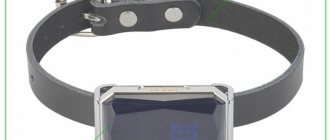The electronic analogue of a human passport for pets is popular in many European countries, but in Russia the implantation of a chip is still performed only as a last resort. This is due to the lack of awareness among owners about the possibilities and benefits of microchipping. However, in the near future, implantation may become as mandatory as regular vaccination.
What is dog microchipping?
Microchipping dogs is becoming an increasingly popular technology, which is based on the use of high-tech sensors. A complex system helps to enter into a national and international database all the information about dogs and their owners.
Type and size of microchip for dogs
The chip, microscopic in parameters, is an inductive coil and a microcircuit soldered into a small tank. The latter is a capsule up to 12 mm long and about 2.1 mm in diameter, made of biocompatible material. This greatly reduces the possibility of the reservoir being rejected or displaced under the animal's skin.
The tank weighs about 0.6 g. There are no power sources, so the shelf life is unlimited. The elements in the composition do not create any radiation and are completely safe for pets. Activation occurs only under the influence of a scanner that creates a small electromagnetic field.
Digital data meaning
A special scanner reads a personal number, which is unique and does not change throughout the dog’s life. This code is entered into a single database and cannot be shortened, changed or supplemented. The number includes 15 characters that have a strictly defined meaning:
- The three digits at the beginning of the code indicate the country. For example, for Russia the code 643 is used.
- The next four characters indicate the device manufacturer information.
- The remaining eight characters contain information about the pet (name, color, breed, information about vaccinations) and the owner (name, contacts).
At the request of the four-legged owners, additional information about the dog’s place of residence, his photograph, and information about his pedigree can be entered into the device.
Necessity of the procedure
An electronic chip for dogs has been mandatory for visiting EU countries since 2010. This is a real requirement for allowing four-legged animals to cross the border, and is intended to prevent the import of infected animals. In addition, implantation will not allow replacement of representatives of elite breeds. The owner or breeder can easily recognize the dog and lay claim to it.
To participate in competitions and championships at the international level, it is necessary to have an implanted microcircuit with the pet’s data. Implantation is also recommended for hunting animals, which often get lost during long walks with their owners.
There is no law in our country that forces or obliges owners and breeders to insert an electronic chip into their dog. However, there are amendments regarding the need to identify and register pets. This means that microchipping of dogs in Russia may soon become mandatory.
Cost of implanting a chip in a clinic
Now it's time to find out how much it costs to chip a dog. In metropolitan clinics, the cost of the procedure for implanting a chip into a pet’s withers varies from 700 to 1,400 rubles (in small cities the amount for inserting a chip is 15-20% lower than in Moscow). Plus, in some institutions you will have to pay a certain amount (usually 200-300 rubles) for veterinary workers to restrain the dog. It can be noted that the price of microchipping a dog is quite reasonable, considering that such a procedure is carried out only once in a lifetime.
Advantages and disadvantages
Like any veterinary procedure, introducing a microcircuit under the skin of a pet has its supporters and opponents. Therefore, it is important to evaluate its advantages and disadvantages in advance.
Pros of traveling abroad
Unlike a paper veterinary passport, a microchip cannot be lost. This is very important when traveling abroad, traveling by train or plane.
Compared to branding or tattooing a number on a dog's body, a microchip cannot be changed and has no expiration date. In addition, the brand may become overgrown with hair or become distorted. Finally, in European countries and in the United States there is no corresponding database of tattoos.
How to find missing chipped dogs
If lost, it is much easier to find a microchipped four-legged friend than an unchipped one. To find out contact information about the owner, just bring the lost dog to any veterinary clinic and scan the microcircuit.
There is a single bank of information about chipped dogs, which helps to identify a pet almost anywhere in the world. Electromagnetic radiation frequency standards facilitate the recognition of data from microcircuits of any manufacturer.
If a pet is lost, the owner just needs to report it as lost and wait for information about its whereabouts to arrive. This happens after scanning the implanted device and checking the data of the dog and its owner against a single database.
Contraindications and disadvantages
The procedure is considered absolutely safe for the health of your four-legged friend. However, if the animal is sick or weakened, then implantation may be contraindicated. For example, the device should not be used on dogs with chronic skin conditions or infections.
The disadvantage of using a chip is the impossibility of correcting information about the owner of the animal. This may be necessary if the owner or his contact information changes. To change the information, you will have to remove the old capsule and implant a new one - with different information.
Pros and cons of microchipping pets
Inexperienced owners are wondering: what does microchipping a dog do? The main advantage of the method is its safety. The individual does not experience any complications after inserting the transponder under the skin; it quickly takes root.
It also does not wear out, so it is enough to microchip your pet once. The microcircuit cannot be removed from the body, but it does not lose color and functionality, unlike a breed mark. This guarantees hassle-free participation in exhibitions and export of animals to another country. And, most importantly, it increases the likelihood of the dog returning if it is lost.
Reference! The only drawback is that low-quality models are demagnetized. This leads to the loss of data about the animal, forcing a new microcircuit to be installed.
There is also a black market where low-quality devices are sold. It is impossible to connect them to information systems. Of course they cost less. But there is no practical use from them.
At what age is a chip implanted?
Capsule implantation has virtually no contraindications. Manipulation can be carried out on the puppy after he is 5 or 6 weeks old. Both elderly and pregnant individuals tolerate the procedure well.
The main thing is that the animal is healthy and does not have skin or infectious diseases. In any case, before installing the chip, the veterinarian conducts a full examination and, if everything is in order, microchips the patient.
How is the procedure done?
How are dogs microchipped? Is this procedure painful? And how long does it last? Before the procedure itself, the veterinarian scans the pet. This is required by the rules for microchipping dogs: this way you can make sure that the animal does not yet have a chip. There are no age restrictions for dogs: the capsule can be implanted in puppies starting from 5-6 weeks.
Since the microchip implantation procedure for dogs is not too painful (equal to a regular vaccination), there is no need for pain relief. Most often, the chip is inserted between the dog's shoulder blades. The veterinarian treats the injection site with alcohol, lifts the fold of skin and inserts a needle with a capsule at a certain degree. That's all.
After implantation, the pet is scanned again to confirm the success of the procedure. After this, the chip number is entered into the passport. Sometimes a special sticker with a chip number is glued into it. Then an application for registration in the common database is filled out. As you can see, the procedure is simple and quick. And most importantly - safe. But provided that you entrust this matter to real professionals.
How dogs are microchipped: a description of the process
Implanting a chip is a simple surgical procedure that takes no more than a couple of minutes. Moreover, the process of introducing the capsule itself takes a few seconds.
Preparing the animal
Despite the simplicity of the procedure, it can only be performed by a specialist in the sterile conditions of a veterinary clinic. The introduction requires clarity and accuracy, compliance with hygiene standards and correct determination of the place where the data chip will be implanted.
The veterinarian should examine the patient for the presence of dermatitis and infectious diseases. A few days before your visit to the clinic, you need to take care of flea and anthelmintic treatment for your pet. It is important for the doctor to make sure that the pet has not previously been microchipped, because only one device is allowed to be implanted.
Stages of the procedure
After a thorough examination, the veterinarian checks the functionality of the implanted reservoir. To do this, the microcircuit is scanned to see if the data matches the numbers on the original packaging. In addition, the veterinarian will inspect the tank for integrity. Next, manipulation is carried out with the pet itself:
- The selected place on the dog’s body is treated with a disinfectant composition.
- An applicator is inserted into the withers area, and the capsule is inserted under the skin by gently pressing the piston.
- The implanted capsule is scanned again to verify correct operation.
- To prevent scratching and infection at the puncture site, the doctor recommends that the patient wear a special collar. After 2-3 days, the protection can be removed.
Implantation takes little time and does not require subsequent special care or adherence to a special regime. After a week, the reservoir begins to become overgrown with muscle tissue, which will further prevent the capsule from moving. It is not recommended to bathe or brush your pet for a week.
Registration in the database
After a simple surgical procedure, the veterinarian must register the animal in a unified national database. There are two large resources operating in Russia, which, in turn, flow into international bases. The information indicated on the microcircuit has legal significance and helps to accurately identify the dog.
Information about the pet and the owner entered into the database does not allow the replacement of the four-legged friend and helps to quickly find the dog in case of loss. The barcode from the factory packaging of the microchip is pasted into the pet's passport. An identification card, which is issued to the owner of a four-legged animal, proves ownership of the pet.
How is chipping carried out?
Chip implantation is a simple surgical procedure similar to vaccination. The entire procedure takes only a few minutes, and the implantation process itself takes a couple of seconds.
Before the procedure, as well as after it, the doctor scans the chip to ensure its functionality. Then, under the skin of the animal, in the area under the withers, an injection is made with a special disposable syringe. The contents of the syringe are a solution to facilitate administration and the chip itself.
Measuring approximately 2 by 12 mm or 1.4 by 8.5 mm (slightly larger than a grain of rice), the microchip is enclosed in a bioglass capsule. This type of glass is absolutely harmless and compatible with the tissues of a living organism. Within a week after the procedure, the biocapsule is surrounded by living tissue and becomes motionless and imperceptible to the animal.
After the injection, the implanted chip is scanned again. The original electronic chip number consists of 15 digits, which encrypt the country code or manufacturer code. The clinic where the procedure was performed enters the information into the database. In Russia at the moment the two largest databases are: www.animal-id.ru and animalface.ru. They are part of international systems. Animal-ID is in Petmaxx, and AnimalFace is in Petmaxx and EuroPetNet.
A sticker with a barcode is pasted into the veterinary passport and pedigree of the dog. It is not recommended to wash the animal for 2 days after the procedure.
Microchipping of dogs is carried out once in the life of the pet. In just a few minutes, the four-legged animal becomes the owner of an electronic number, which is assigned to it once and for all.
Misconceptions and important facts
Although there are many benefits to microchipping your dog, there are persistent prejudices and misconceptions. For example, most owners believe that an inserted capsule with information will make it possible to track a missing animal via satellite. Only a GPS tracker has this function, which can be placed on a collar - but not in the animal’s body.
Other facts you need to know before going to the veterinary clinic:
- The procedure will only be painless if it is performed by an experienced veterinarian. Sometimes the doctor simply pierces the top layer of skin with a needle, and the capsule may subsequently fall out and get lost. This sometimes happens with long-haired breeds.
- The biocompatible material of the reservoir causes allergies in a small percentage of four-legged animals. This manifests itself in inflammation and the formation of pus at the puncture site.
- The shelf life of the microcircuit is not limited, but before the trip it is worth checking the properties using a scanner at the veterinary clinic. This will avoid an unpleasant situation while crossing the border. One of the causes of failure is demagnetization.
The effectiveness of using data chips has been proven by many years of experience in different European countries. An international information base, the presence of scanners in clinics, shelters, nurseries, and the use of reading devices by catching services and customs officers at the border with other countries help to quickly identify and return a lost four-legged animal to its owner. In our country, this multi-stage system is just beginning to develop.
Why should you do this?
Let's talk about why dogs need to be microchipped? Most often this is done by owners who often travel with their pets throughout the European Union. Without a chip, your pet will not be allowed at the border. But this does not mean that dogs who do not travel the world do not need this chip. They need it no less than traveling dogs.
Previously, it was popular to make a brand or hang the dog’s name and owner’s number on the collar. Over time, many have become convinced that this is not the most reliable way to protect themselves and their pets. Therefore, over the course of 20 years, dog microchipping has become actively used.
Where and at what price are dogs microchipped?
To carry out surgical manipulation, you must contact a specialized veterinary clinic. Only in this case the procedure will go smoothly, and the data will be accurately entered into the common database.
More and more animal clinics are appearing in Russia that provide this service. Its cost is quite affordable. For example, in Moscow and the Moscow region, implantation costs from 600 to 2000 rubles. This price range is due to the location and popularity of the clinic.
In the Leningrad region and St. Petersburg the cost is slightly lower, it reaches 1,500 rubles. In other regions, the minimum price is 500 rubles, and the maximum is 1200 rubles. Before contacting the hospital of your choice, it is a good idea to read customer reviews.
Microchipping of dogs is not a mandatory procedure in our country. However, it helps to quickly find a lost pet and travel abroad with it. Without an implanted device, you cannot participate in international competitions and championships. The cost makes the service accessible to different categories of citizens who want to protect their pet from the fate of a homeless person.
The article is of a recommendatory nature. Contact a specialist!
Where can it be done, cost of chipping
Having figured out how chipping works and what is generally meant by this procedure, you need to find out where it can be done and how much it will cost. You can have your pet microchipped at any veterinary clinic that has a supply of chips.
It is advisable to find out in advance what transponders the clinic uses. Check reviews for their quality. This way you won’t be disappointed in the procedure, won’t lose access to data about the animal due to the poor quality of the device, and won’t needlessly put your dog into a state of stress.
Information! The cost of installing a microcircuit in the regions ranges between 1000 and 2000 rubles, including the tracker itself.
This is not so much, so the procedure is recommended for both show animals and dogs without a good pedigree. This is important because any dog can go missing.










